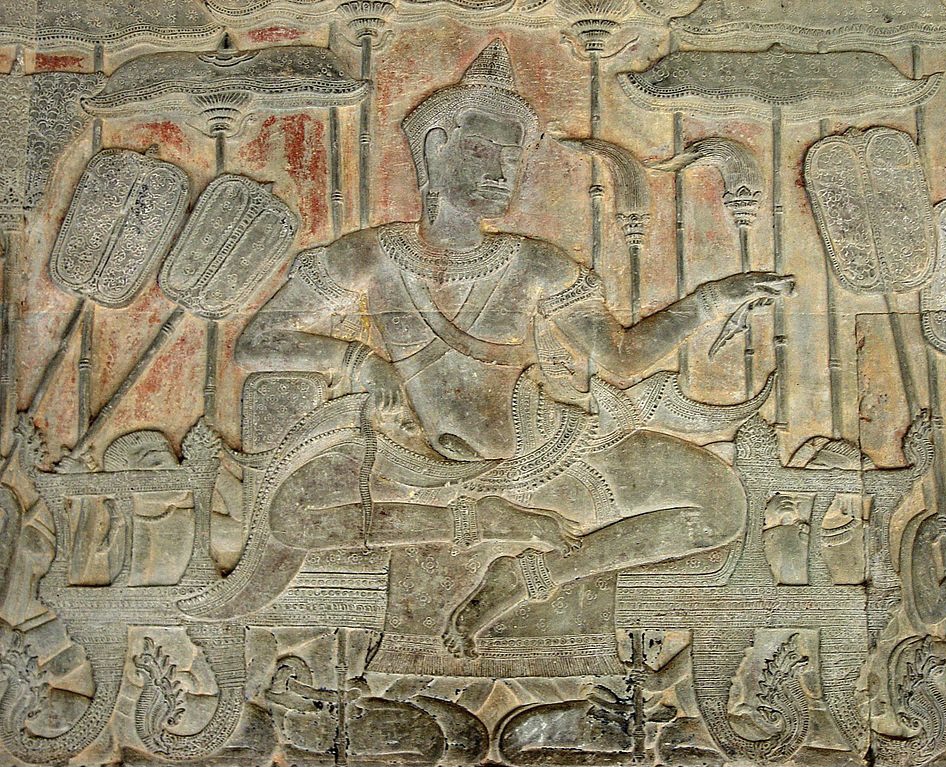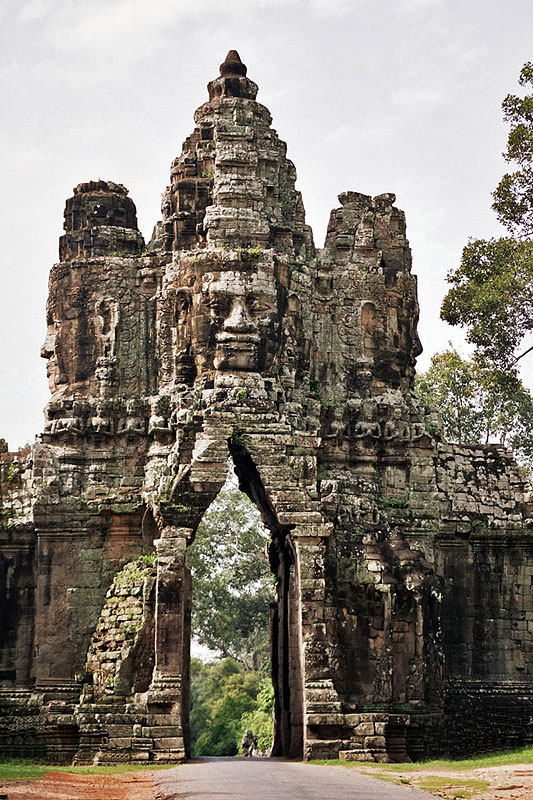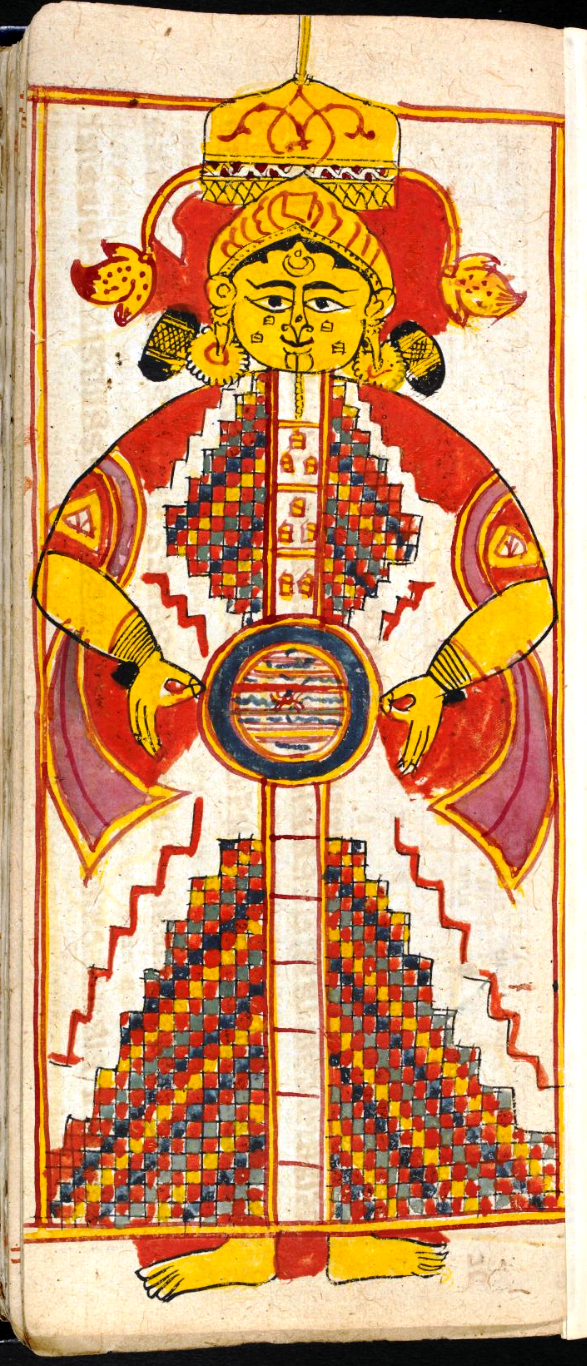|
Angkor Wat
Angkor Wat (; km, អង្គរវត្ត, "City/Capital of Temples") is a temple complex in Cambodia and is the largest religious monument in the world, on a site measuring . Originally constructed as a Hindu temple dedicated to the god Vishnu for the Khmer Empire by King Suryavarman II, it was gradually transformed into a Buddhist temple towards the end of the 12th century; as such, it is also described as a "Hindu-Buddhist" temple. Angkor Wat was built at the behest of the Khmer King Suryavarman II in the early 12th century in Yaśodharapura ( km, យសោធរបុរៈ, present-day Angkor), the capital of the Khmer Empire, as his state temple and eventual mausoleum. Angkor Wat combines two basic plans of Khmer temple architecture: the temple-mountain and the later galleried temple. It is designed to represent Mount Meru, home of the devas in Hindu mythology: within a moat more than 5 kilometres (3 mi) long and an outer wall long are three rectan ... [...More Info...] [...Related Items...] OR: [Wikipedia] [Google] [Baidu] |
Angkor
Angkor ( km, អង្គរ , 'Capital city'), also known as Yasodharapura ( km, យសោធរបុរៈ; sa, यशोधरपुर),Headly, Robert K.; Chhor, Kylin; Lim, Lam Kheng; Kheang, Lim Hak; Chun, Chen. 1977. ''Cambodian-English Dictionary''. Bureau of Special Research in Modern Languages. The Catholic University of America Press. Washington, D.C. Chuon Nath Khmer Dictionary (1966, Buddhist Institute, Phnom Penh). was the capital city of the Khmer Empire. The city and empire flourished from approximately the 9th to the 15th centuries. The city houses the Angkor Wat, one of Cambodia's most popular tourist attractions. The name ''Angkor'' is derived from ''nokor'' (), a Khmer word meaning "kingdom" which in turn derived from Sanskrit ''nagara'' (), meaning "city". The Angkorian period began in AD 802, when the Khmer Hindu monarch Jayavarman II declared himself a "universal monarch" and " god-king", and lasted until the late 14th century, first falling under ... [...More Info...] [...Related Items...] OR: [Wikipedia] [Google] [Baidu] |
Siem Reap
Siem Reap ( km, សៀមរាប, ) is the second-largest city of Cambodia, as well as the capital and largest city of Siem Reap Province in northwestern Cambodia. Siem Reap has French colonial and Chinese-style architecture in the Old French Quarter and around the Old Market. In the city, there are museums, traditional Apsara dance performances, a Cambodian cultural village, souvenir and handicraft shops, silk farms, rice paddies in the countryside, fishing villages and a bird sanctuary near Tonlé Sap, and a cosmopolitan drinking and dining scene. Cambodia’s Siem Reap city, home to the famous Angkor Wat temples, was crowned the ASEAN City of Culture for the period 2021–2022 at the 9th Meeting of the ASEAN Ministers Responsible for Culture and Arts (AMCA) organised on Oct 22, 2020. Siem Reap today—being a popular tourist destination—has many hotels, resorts, and restaurants. This owes much to its proximity to the Angkor Wat temples, Cambodia's most popular tou ... [...More Info...] [...Related Items...] OR: [Wikipedia] [Google] [Baidu] |
Moat
A moat is a deep, broad ditch, either dry or filled with water, that is dug and surrounds a castle, fortification, building or town, historically to provide it with a preliminary line of defence. In some places moats evolved into more extensive water defences, including natural or artificial lakes, dams and sluices. In older fortifications, such as hillforts, they are usually referred to simply as ditches, although the function is similar. In later periods, moats or water defences may be largely ornamental. They could also act as a sewer. Historical use Ancient Some of the earliest evidence of moats has been uncovered around ancient Egyptian castles. One example is at Buhen, a castle excavated in Nubia. Other evidence of ancient moats is found in the ruins of Babylon, and in reliefs from ancient Egypt, Assyria, and other cultures in the region. Evidence of early moats around settlements has been discovered in many archaeological sites throughout Southeast Asia, including ... [...More Info...] [...Related Items...] OR: [Wikipedia] [Google] [Baidu] |
Loka
Loka () is a concept in Hinduism and other Indian religions, that may be translated as a planet, the universe, a plane, or a realm of existence. In some philosophies, it may also be interpreted as a mental state that one can experience. A primary concept in several Indian religions is the idea that different lokas are home to various divine beings, and one takes birth in such realms based on their karma. Hinduism Three lokas The most common classification of lokas in Hinduism is the Trailokya, or the three worlds. The concept of the three worlds has a number of different interpretations in Hindu cosmology. In Hindu literature, the three worlds refer to either the earth (Bhuloka), heaven (Svarga), and hell ( Naraka), or the earth (Bhuloka), heaven (Svarga), and the netherworld ( Patala) Bhuloka In the Narada Purana, Bhuloka is identified with the planet Earth, the world of human beings. It is described to be split up into seven regions, referred to as dvipas (islands). T ... [...More Info...] [...Related Items...] OR: [Wikipedia] [Google] [Baidu] |
Stele
A stele ( ),Anglicized plural steles ( ); Greek plural stelai ( ), from Greek , ''stēlē''. The Greek plural is written , ''stēlai'', but this is only rarely encountered in English. or occasionally stela (plural ''stelas'' or ''stelæ''), when derived from Latin, is a stone or wooden slab, generally taller than it is wide, erected in the ancient world as a monument. The surface of the stele often has text, ornamentation, or both. These may be inscribed, carved in relief, or painted. Stelae were created for many reasons. Grave stelae were used for funerary or commemorative purposes. Stelae as slabs of stone would also be used as ancient Greek and Roman government notices or as boundary markers to mark borders or property lines. Stelae were occasionally erected as memorials to battles. For example, along with other memorials, there are more than half-a-dozen steles erected on the battlefield of Waterloo at the locations of notable actions by participants in battle. A traditio ... [...More Info...] [...Related Items...] OR: [Wikipedia] [Google] [Baidu] |
Shaivism
Shaivism (; sa, शैवसम्प्रदायः, Śaivasampradāyaḥ) is one of the major Hindu traditions, which worships Shiva as the Supreme Being. One of the largest Hindu denominations, it incorporates many sub-traditions ranging from devotional dualistic theism such as Shaiva Siddhanta to yoga-orientated monistic non-theism such as Kashmiri Shaivism.Ganesh Tagare (2002), The Pratyabhijñā Philosophy, Motilal Banarsidass, , pages 16–19 It considers both the Vedas and the Agama texts as important sources of theology.Mariasusai Dhavamony (1999), Hindu Spirituality, Gregorian University and Biblical Press, , pages 31–34 with footnotesMark Dyczkowski (1989), The Canon of the Śaivāgama, Motilal Banarsidass, , pages 43–44 Shaivism developed as an amalgam of pre-Vedic religions and traditions derived from the southern Tamil Shaiva Siddhanta traditions and philosophies, which were assimilated in the non-Vedic Shiva-tradition. In the process of Sanskriti ... [...More Info...] [...Related Items...] OR: [Wikipedia] [Google] [Baidu] |
Brahmin
Brahmin (; sa, ब्राह्मण, brāhmaṇa) is a varna as well as a caste within Hindu society. The Brahmins are designated as the priestly class as they serve as priests ( purohit, pandit, or pujari) and religious teachers (guru or acharya). The other three varnas are the Kshatriya, Vaishya and Shudra. The traditional occupation of Brahmins is that of priesthood at the Hindu temples or at socio-religious ceremonies, and rite of passage rituals such as solemnising a wedding with hymns and prayers.James Lochtefeld (2002), Brahmin, The Illustrated Encyclopedia of Hinduism, Vol. 1: A–M, Rosen Publishing, , page 125 Traditionally, the Brahmins are accorded the highest ritual status of the four social classes. Their livelihood is prescribed to be one of strict austerity and voluntary poverty ("A Brahmin should acquire what just suffices for the time, what he earns he should spend all that the same day"). In practice, Indian texts suggest that some Brahmins hist ... [...More Info...] [...Related Items...] OR: [Wikipedia] [Google] [Baidu] |
Baphuon
The Baphuon ( km, ប្រាសាទបាពួន) is a temple at Angkor, Cambodia. It is located in Angkor Thom, northwest of the Bayon. It is Bhuddha Vihar History Built in the mid-11th century, it is a three-tiered temple mountain built as the state temple of Udayadityavarman IIHigham, C., 2001, The Civilization of Angkor, London: Weidenfeld & Nicolson, dedicated to the Hindu God Shiva. It is the archetype of the Baphuon style with intricate carvings covering every available surface. The temple adjoins the southern enclosure of the royal palace and measures 120 metres east-west by 100 metres north-south at its base and stands 34 meters tall without its tower, which would have made it roughly 50 meters tall. Its appearance apparently impressed Temür Khan's late 13th century envoy Zhou Daguan during his visit from 1296 to 1297, who said it was 'the Tower of Bronze...a truly astonishing spectacle, with more than ten chambers at its base.' In the late 15th centu ... [...More Info...] [...Related Items...] OR: [Wikipedia] [Google] [Baidu] |
Suryavarman II
Suryavarman II ( km, សូរ្យវរ្ម័នទី២), posthumously named Paramavishnuloka, was a Khmer Empire, Khmer king from 1113 AD to 1145/1150 AD and the builder of Angkor Wat, the largest religious monument in the world which he dedicated to the Hindu god Vishnu. His reign's monumental architecture, numerous military campaigns and restoration of strong government have led historians to rank Suryavarman as one of the empire's greatest kings. Early years Suryavarman appears to have grown up in a provincial estate, at a time of weakening central control in the empire. An inscription lists his father as Ksitindraditya and his mother as Narendralakshmi. As a young prince, he maneuvered for power, contending he had a legitimate claim to the throne. “At the end of his studies,” states an inscription, “he approved the desire of the royal dignity of his family.” He appears to have dealt with a rival claimant from the line of Harshavarman III, probably Nripatindra ... [...More Info...] [...Related Items...] OR: [Wikipedia] [Google] [Baidu] |
Devanāgarī
Devanagari ( ; , , Sanskrit pronunciation: ), also called Nagari (),Kathleen Kuiper (2010), The Culture of India, New York: The Rosen Publishing Group, , page 83 is a left-to-right abugida (a type of segmental writing system), based on the ancient ''Brāhmī'' script, used in the northern Indian subcontinent. It was developed and in regular use by the 7th century CE. The Devanagari script, composed of 47 primary characters, including 14 vowels and 33 consonants, is the fourth most widely adopted writing system in the world, being used for over 120 languages.Devanagari (Nagari) , Script Features and Description, (2013), United States The < ... [...More Info...] [...Related Items...] OR: [Wikipedia] [Google] [Baidu] |
Pali
Pali () is a Middle Indo-Aryan liturgical language native to the Indian subcontinent. It is widely studied because it is the language of the Buddhist '' Pāli Canon'' or '' Tipiṭaka'' as well as the sacred language of '' Theravāda'' Buddhism.Stargardt, Janice. ''Tracing Thoughts Through Things: The Oldest Pali Texts and the Early Buddhist Archaeology of India and Burma.'', Royal Netherlands Academy of Arts and Sciences, 2000, page 25. Early in the language's history, it was written in the Brahmi script. Origin and development Etymology The word 'Pali' is used as a name for the language of the Theravada canon. The word seems to have its origins in commentarial traditions, wherein the (in the sense of the line of original text quoted) was distinguished from the commentary or vernacular translation that followed it in the manuscript. K. R. Norman suggests that its emergence was based on a misunderstanding of the compound , with being interpreted as the name of a particu ... [...More Info...] [...Related Items...] OR: [Wikipedia] [Google] [Baidu] |
Sanskrit
Sanskrit (; attributively , ; nominalization, nominally , , ) is a classical language belonging to the Indo-Aryan languages, Indo-Aryan branch of the Indo-European languages. It arose in South Asia after its predecessor languages had Trans-cultural diffusion, diffused there from the northwest in the late Bronze Age#South Asia, Bronze Age. Sanskrit is the sacred language of Hinduism, the language of classical Hindu philosophy, and of historical texts of Buddhism and Jainism. It was a lingua franca, link language in ancient and medieval South Asia, and upon transmission of Hindu and Buddhist culture to Southeast Asia, East Asia and Central Asia in the early medieval era, it became a language of religion and high culture, and of the political elites in some of these regions. As a result, Sanskrit had a lasting impact on the languages of South Asia, Southeast Asia and East Asia, especially in their formal and learned vocabularies. Sanskrit generally connotes several Indo-Aryan lang ... [...More Info...] [...Related Items...] OR: [Wikipedia] [Google] [Baidu] |







_Bhumi_Puja%2C_yajna.jpg)



